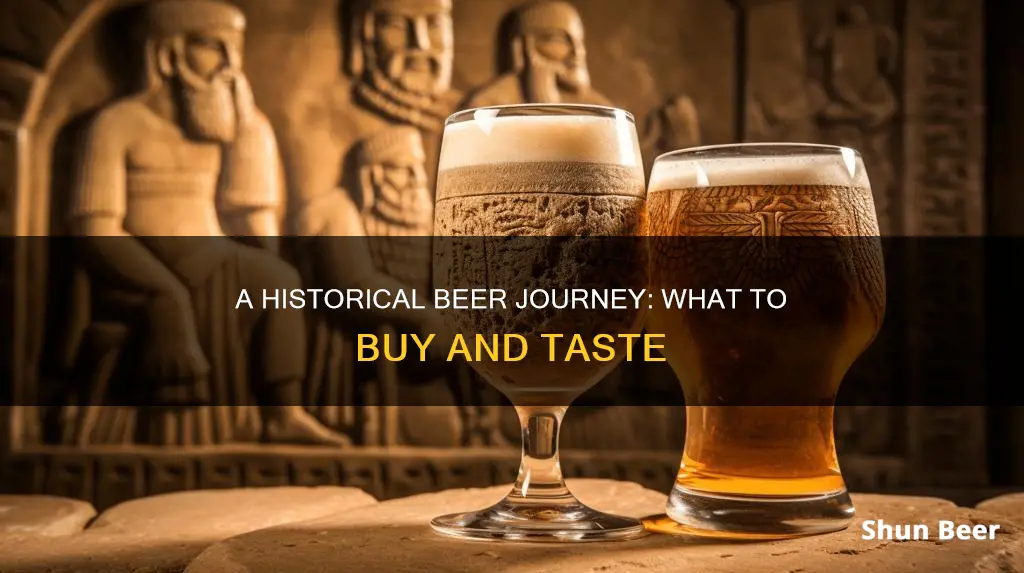
Beer is one of the oldest human-produced drinks, with evidence of its production dating back thousands of years. The earliest archaeological evidence of beer was found in the Raqefet Cave in the Carmel Mountains near Haifa, Israel, where 13,000-year-old residues of a beer with the consistency of gruel were discovered. The written history of ancient Egypt and Mesopotamia also mentions the use of beer, with a 3,900-year-old Sumerian poem honouring Ninkasi, the patron goddess of brewing, containing the oldest surviving beer recipe. Over time, the production of beer has evolved from small-scale domestic brewing to large-scale industrial manufacturing, with the development of new technologies and processes influencing the taste, quality, and accessibility of beer. Today, the brewing industry is a global business, with a diverse range of beer styles and a growing market fuelled by craft breweries and innovative flavours.
What You'll Learn

Ancient beer recipes
Around 5,000 years ago, workers in the city of Uruk (modern-day Iraq) were paid in beer by their employers. During the construction of the Egyptian pyramids, each worker received a daily ration of four to five litres of beer, which served as both nutrition and refreshment.
Ancient beers were often thick and more gruel-like than liquid, and the Sumerians used drinking straws to avoid the bitter solids left over from fermentation.
Sumerian Beer
The oldest surviving beer recipe is a 3,900-year-old Sumerian poem, "The Hymn to Ninkasi", honouring the patron goddess of brewing. The recipe involves malting some wheat berries, then soaking them with water, yeast, date syrup, and a par-cooked, fermented loaf of barley dough. The process takes about a week and results in a mild, pale brew that is only 2% alcohol.
Ancient Egyptian Beer
Ancient Egyptian beer-making often started in a bakery, where brewers would thresh, winnow, and sift the grain through sieves made of rushes. They would then grind the grain using mortars and pestles and work the coarse flour into bell-shaped, moist loaves called cyllestis, which they would bake in beehive-shaped ovens. The loaves would then be divided into quarters and soaked in water.
The ancient Egyptians often fortified their brews with dates and honey and flavoured them with herbs and spices. They did not use hops, but instead used ginger and mandrake root.
Ancient Beer in China
Around 7,000 years ago, Chinese villagers brewed fermented alcoholic drinks on a small, individual scale. They used malted grain and grain converted by mould, although the latter process was largely considered inefficient compared to using mould cultivated on rice.
Austrian Beer: Where to Buy the Best Brews
You may want to see also

Beer in the Middle Ages
Beer is one of the oldest human-produced drinks, with the written history of ancient Egypt and Mesopotamia recording its use. In Europe during the Middle Ages, beer was consumed daily by all social classes in the northern and eastern parts of the continent, where grape cultivation was difficult or impossible. Brewing was considered a common household task, often orchestrated by women.
In the early Middle Ages, monks and members of noble families drank beer for lunch (and wine for dinner). However, by the 14th and 15th centuries, beer had replaced wine for many people in some parts of northern Europe. Beer was a democratic beverage—most people could afford it, and it was also often consumed by servants and ladies of large noble households. Students in the Middle Ages, who were low-level clergymen, could enjoy their beer tax-free.
The quality of beer changed significantly around the year 1200. Brewers in Bremen, Germany, determined the exact amount and type of hops to add to the beer so that it could be stored for up to six months. This meant that beer could be shipped as far away as England and the Low Countries, and more people started to drink and make beer.
There was a great variety of brews in the Middle Ages, named based on their colour, heaviness, price, and other factors. Some beers had lower alcohol content and were drunk for breakfast, while stronger beers were consumed for lunch and dinner and at the end of the day. People in 16th-century cities drank about 250 litres of beer per person per year—approximately three-quarters of a litre a day.
The use of hops in beer was first written about in 822 by the Carolingian Abbot Adalard of Corbie. However, flavouring beer with hops was not widely adopted until later due to difficulties in establishing the right proportions. Before that, gruit—a mix of various herbs—was used, but it did not have the same preserving properties as hops. Beer flavoured without hops often spoiled soon after preparation and could not be exported.
Buying Beer in Ellicottville, NY: Where to Go?
You may want to see also

Beer and the Industrial Revolution
Beer is one of the oldest human-produced alcoholic drinks, with the earliest archaeological evidence of beer-making dating back 13,000 years. Before the Industrial Revolution, beer was mainly brewed and sold on a domestic scale, though European monasteries had been producing and selling beer since the 7th century CE.
The Industrial Revolution, which began in Great Britain in the 18th century, brought about significant changes in the production of beer. The development of the steam engine, the thermometer, and the hydrometer changed brewing from a cottage industry to a machine-driven big business.
Steam Engine
In 1777, Messrs Cook & Co at Stratford-le-Bow, just east of London, became the first brewery to install a steam engine. The steam engine helped create a constant temperature in cylinders and increased efficiency by saving 75% on coal usage. The engines were initially purchased for milling large quantities of grain and for pumping operations, but breweries soon found many more uses for them. By 1835, the steam engine was also being used in the iron-making process, mechanical refrigeration, and improved transportation through railways and canals.
Thermometer and Hydrometer
The invention of the thermometer in 1760 and the hydrometer in 1770 allowed brewers to have greater control over the brewing process. Before their invention, beer was brewed from a single malt—brown beers from brown malt, amber beers from amber malt, and pale beers from pale malt. With the hydrometer, brewers could calculate the yield from different malts and discovered that pale malt yielded more fermentable material, leading them to switch to using mostly pale malt for all beers. The thermometer helped brewers find the right temperatures for brewing.
Coffee Roaster
The invention of the coffee roaster by Daniel Wheeler in 1815 also contributed to the improvement of the brewing process. It made it possible to roast malt without the undesirable smoky taste and allowed for better control of the roasting process.
Yeast Studies
Studies and discoveries by Louis Pasteur on yeast and alcoholic fermentation gave brewers a better understanding of the chemistry of transformation, leading to an improved production process and the possibility of long-term preservation (pasteurization).
During the Industrial Revolution, beer production moved from artisanal manufacture to industrial manufacture, and domestic manufacture ceased to be significant by the end of the 19th century. The various innovations of the time revolutionized the beer industry, making it possible to mass-produce beer and improve its quality and preservation.
Carrollton, Texas Beer Buying Hours Explained
You may want to see also

Beer packaging
Ancient Times
Beer is one of the oldest alcoholic drinks, with evidence of its production dating back thousands of years. In ancient times, beer was often brewed domestically and sold in large, wooden barrels or "kegs" made by artisans called "coopers". These barrels were bulky and heavy, but they allowed for the transportation of large amounts of beer to local pubs and across oceans. Customers would bring their own containers, marked with personal identifiers such as family seals or coats of arms.
18th and 19th Centuries
In the 18th century, beer engines (pumps) were developed in England, allowing bartenders to draw beer from a keg located in the basement of a pub up to the bar on the first floor. In the 19th century, beer bottling and labelling became more common. Glass bottles in various colours, including clear, blue, green, and brown, were used to contain beer. Brown glass, which screens out harmful UV rays, is considered the best at preserving beer and preventing spoilage.
20th Century to Present
In the early 20th century, brewers transitioned from wooden kegs to carbon dioxide-pressured steel kegs. During the World Wars, bottles were in short supply, but after the wars, beer sales, particularly for bottled beer, increased as people could enjoy a cold drink at home with their families. In 1933, near the end of Prohibition, the American Can Company introduced steel cans for beer, providing new possibilities for consumption. In 1958, the Hawaii Brewery introduced beer in aluminium cans, which quickly gained popularity due to their lightweight and convenient design. Today, canned beer is the most popular method of packaging beer, with aluminium cans making up 62% of beer volume produced and sold in the United States.
Sweetwater Beer Availability: Where and How to Buy
You may want to see also

Beer in the 21st century
The 21st century has seen the continued expansion of home brewing, microbreweries, and brewpubs. In the US, the number of breweries has increased from 407 in the early 2000s to over 1,400 in 2010, with a large proportion of these being microbreweries. The craft beer movement has also gained momentum, with the number of barrels of craft beer quadrupling from 2008 to 2018.
In 2002, South African Breweries bought the North American Miller Brewing Company to found SABMiller, which became the second-largest brewery in the world after North American Anheuser-Busch. In 2004, the Belgian Interbrew was the third-largest brewery by volume, and the Brazilian AmBev was the fifth-largest. They merged to form InBev, which then became the largest brewery in the world after buying Anheuser-Busch in 2008. As of 2020, AB InBev remains the largest brewing company in the world, with Heineken second, CR Snow third, Carlsberg fourth, and Molson Coors fifth.
The market for beer has become increasingly segmented, with dozens of sub-categories developed for specific moods, activities, or types of drinkers. Pale ales, for example, can be citrusy and hoppy, or easier on the palate, so-called session ales designed for longer drinking sessions. Stouts and porters can have notes of chocolate, coffee, or marshmallows. Even lager, one of the most commonly drunk beers in the world, has caught the attention of craft brewers aiming to create a pilsner that can compete with malty brown ales and craft IPAs.
The rise of craft beer has also led to a revival of small breweries, with many independent breweries now competing at the top level. Examples include Drygate, Brewdog, and Williams Brothers. These breweries tend to focus on their connection to the local community in their marketing, tying in with the rise in popularity of farmers' markets and the perception that artisanal food and drink is of higher quality than mass-produced products.
In terms of packaging, canned beer outsold bottled beer in the US for the first time in 2004. In Sweden in 2001, 63.9% of beer was sold in cans.
In 2010, China's beer consumption hit 450 billion litres, or nearly twice that of the United States, but only 5% of this was premium beer, compared with 50% in France and Germany. A 2018 study suggested that sudden decreases in barley production due to extreme drought and heat could cause substantial volatility in the availability and price of beer in the future.
Cheboygan Beer: Where to Buy the Blood Orange Brew
You may want to see also
Frequently asked questions
Beer is one of the oldest alcoholic drinks in the world and is mentioned in some of the earliest-known writings. The earliest archaeological evidence of beer was found in the Raqefet Cave in the Carmel Mountains near Haifa in northern Israel. This beer dates back 13,000 years and was used for ritual feasting by the semi-nomadic Natufians.
The strongest beer in the world is The End of History, an ultra-limited-edition 55% ABV Belgian ale brewed by BrewDog. Only 12 bottles were made, and they were presented in taxidermied roadkill.
In early forms of English, the word "ale" was used for any alcoholic drink. The modern word "beer" came into present-day English from Old English and referred to hopped ale imported from Europe. Today, the difference between ale and beer is the type of yeast and fermentation process used. Ale is fermented at room temperature with a yeast that rises to the top, while beer (or lager) is fermented at cool temperatures with a yeast that sinks to the bottom.
The best way to drink beer depends on personal preference. However, the temperature of the beer can influence the drinker's experience. Warmer temperatures reveal the range of flavours in a beer, while cooler temperatures are more refreshing. Most drinkers prefer pale lager served chilled, while darker beers such as stout are typically served at room temperature.







